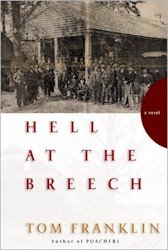
The Missing by Tim Gautreaux
I love Tim Gautreaux's dedication pages. In his debut short story collection, Same Place, Same Things, he writes, "For my wife, Winborne, and our two sons, Robert and Thomas. I would also like to thank the National Endowment for the Arts. I suppose I could have thanked them first, but they haven't ever baked me biscuits." Welding With Children, the second collection, is dedicated "To my teachers, who knew that every fact is a coin." And in The Missing, Gautreaux offers this dedication: "For my father, Minos Lee Gautreaux, who taught me to love children and steamboats."
These three dedications say a good deal about the kind of stories Gautreaux writes, old-fashioned tales where the best characters are not those who achieve great deeds, but those able to happily inhabit modest lives, enjoy simple pleasures, and act in a spirit of decency, kindness, and responsibility towards their fellow travelers in the world. In Gautreaux's universe, these qualities bring about their own rewards, while their inverse invite a host of miseries.
If this vision sounds impossibly naive and wholesome to you, then you've clearly never experienced the joy of reading a Tim Gautreaux book. It works because Gautreaux isn't prone to dewy-eyed nostalgia for a golden small town America, and he understands that even the best of us can't save ourselves from loss, pain, and the hundreds of small meannesses that people enact upon one another.
Sam Simoneaux, the protagonist of The Missing, is a man who has known that kind of loss. When he was a baby, Sam's entire family was gunned down in a vengeance killing, himself spared only because his father managed to hide him in a cold furnace. At the book's beginning, he and his wife have just lost their infant son to a fever. And then, on his watch as a floorwalker in a New Orleans department store, a little girl named Lily is kidnapped. It's 1921, and between spotty local law enforcement, slow communications, and widespread shady adoption practices of the time, the chances of recovering her are slim.
After the kidnapping, Sam loses his job, and guilt-ridden, tracks down Lily's parents and offers to help find her. The girl's parents are performers on a steamboat that specializes in pleasure cruises up and down the Mississippi. Suspecting someone might have noticed Lily on one of these cruises, Sam joins the crew as a third mate, responsible for frisking passengers for weapons, breaking up fistfights, and playing piano with the band whenever their itinerary takes them to a backwater where the boat's black orchestra might be in danger.
It's in these parts of the book that Gautreaux's writing feels most colorful and lived in, which isn't surprising as his grandfather was a steamboat captain and his father, a tugboat captain. All along the river, Sam puts out feelers, makes connections, and ventures into territories populated by generations of violent outlaws who operate outside the jurisdiction of any law enforcement.
As Sam's quest brings him closer to finding Lily, it also brings up old questions about his family's fate, and he faces the problem of how a good man can earn justice when the law is corrupt or indifferent, and the lawless go unpunished. The answers are hard-won, and the book's conclusion is both satisfying and bittersweet.
I checked this book out from the library, but after reading it, I plan to go out and buy a copy. Like all of Tim Gautreaux's books, I suspect this is one I'll be reading and re-reading for years to come.
And if you haven't read Gautreaux's short stories, "Floyd's Girl" and "Died and Gone to Vegas" are two of our favorites. My favorite story, "The Courtship of Merlin LeBlanc," isn't available online, but it's in Same Place, Same Things, and is well worth your time.





















